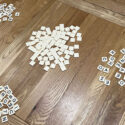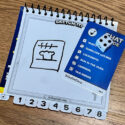Top 4: Board Games to Play this Easter!
After Christmas, Easter is the largest public holiday where it is generally considered acceptable to tuck in to a huge family dinner and then eat chocolate on the sofa until you can no longer function. For me, there’s no better time to play games than when family is together, and a distraction from awful Bank Holiday television and something to keep the kids entertained during their two-week break from school is essential – of course, I turn to board games to fill this gap.
Working with our long-time collaborators at Asmodee UK, we’ve hand-picked four games that are the right price, complexity and length to play with casual gamers and younger players over the Easter holiday. Among these are a couple of classic games that may well be familiar to anyone who has been in the gaming hobby for a while, but if you’re like me, you might have dismissed them as being “too light.” I can confirm that every game on this list has been played and enjoyed by both core gamers (me and my friends) and audiences who aren’t as familiar with modern games, including my children and extended family.

Love Letter (and its many variants):
Whilst Love Letter has been reprinted many times over the years to include Batman, Star Wars and most recently even Bridgerton variants, the basic Love Letter is the focus here. Love Letter consists of about thirty cards and a handful of nice plastic tokens that are packaged inside a cute velvet bag. Love Letter is so compact that not only is it ideal for a handbag or a kids rucksack, it would even fit in your coat pocket if needed.
The basic concept is simple – you want to deliver a love letter to the Princess, and you will use your influence on her courtiers (represented by cards) to do so. Each player begins with one card in hand and then draws another on their turn – they will choose one of these to keep and then play the other. Every card has a value and an ability – when the card is played, the ability is triggered. If the deck runs out, all players reveal their cards and whoever has the highest numbered card will win.
The decision space in Love Letter is small and focused, but it feels intense. High-value cards like the princess or the countess will win if you can keep them to the end, but in the princess’ case, if an opponent forces you to reveal her then you’ll lose immediately. With the countess, you may be forced to play your other card if it’s a king or prince, which again gives opponents valuable insight that they can exploit with a guard – which when played allows a player to guess at what card their opponent has and potentially excludes them from the game. Fast, simple, fun and competitive, Love Letter is the perfect game for a family get-together.
Bananagrams:
If you have players in your group who want a game that is a bit more classical in feel, albeit with a modern twist, then Bananagrams might be for you. This game comes in a large banana-shaped canvas bag, and simply contains a huge pile of letters that are pretty reminiscent of Scrabble, but without points on them. That’s because in Bananagrams rather than playing in a structured way, you will race against the clock to use all your letters in a personal grid and the first to do so, wins.
Bananagrams is fast-paced and fun, with methods for ensuring that younger players have a bit of an advantage by varying the number of letters available to them. The idea is that if you ever run out of words, you simply draw more tiles, so even as your grid expands with new words, your hand of letters will increase whenever you can’t place them. If there’s any drawback to Bananagrams, it’s only that the game is so fast-paced and chaotic that any bumps to the table or knocks on your letter grid can result in a bit of chaos. Nonetheless, Bananagrams is a quick and familiar feeling game that just about anyone can play.
The Sock Game:
To be honest, I didn’t think I’d like The Sock Game much when I first saw it. This relentless silly party game seems almost too simple, too silly and dare I say it – not really a game. However, I was very wrong, because The Sock Game is tremendous fun. There are two variants involving either a head-to-head sort of “race” to find a single item within a sock against a single opponent, or there is a sock race team variant where players spin a wheel to determine five random items, and then they pass the sock between team members until all items have been found.
Regardless of the variant you are playing, anyone can grasp the concept of putting their hand into a sock and rummaging around until you find what you are looking for – but it’s definitely not as simple as it sounds. With about 20 bits and bobs included for each of the two teams, The Sock Game is deceptively difficult. Many of the items feel the same, and with the proper rules suggesting that you can only use one hand on the sock at any time, locating what you want just by feel alone (with everything else jiggling about) is a challenge.
The Sock Game is hilarious fun for players of any age, with the only limitation being the dexterity of your fingers. Younger players with small arms and hands seem to do really well at this game, and it’s amazing how competitive they are once the game gets going. The Sock Game is definitely one to get your whole family laughing and joking following a heavy dinner, and whilst it works well with kids, it’s also a great party game for older players after having had a few drinks.
Telestrations:
Perhaps my favourite game in this list, Telestrations is another game that will have some classic ideas that older players are familiar with – although this time the linkage feels more closely aligned to certain 1980’s Saturday night game shows. In a nutshell, each player draws a card and then rolls a dice, which then links to a phrase or word on the card. For example in the pictures I’ve shared, the phrase was “bun in the oven.” The player must then draw an image of their phrase in a wipeable, flip-book. When everyone is done the books are passed on and the next player must look at the picture and then on the next page, write what they thought it was.
This continues until the book makes it way back to the original owner, and the way we play is that each player then recounts the story of their card – beginning with their picture, then the interpretation, the following picture and so on – eventually revealing the intended phrase right at the end. If the final result is even close to what was originally on the card, then that player scores a point – and this is much, much easier said than done – unless you happen to be a family of artists.
Telestrations is really about the experience. Again it’s a game anyone can play, but you really shouldn’t take it too seriously or else you won’t have fun. Young children can sometimes be even better than adults because drawing pictures is so familiar to them, and adults will often end up with crude or lewd interpretations that – depending on your group – can be pretty funny. Alongside Love Letter, Telestrations is my favourite game in this list and one that I am always happy to play.
______
And there you have it – four fantastic games to play with your family this Easter. Why not let us know in the comments if you have any of these games, and if so which ones you enjoy and how you like to play!

















































